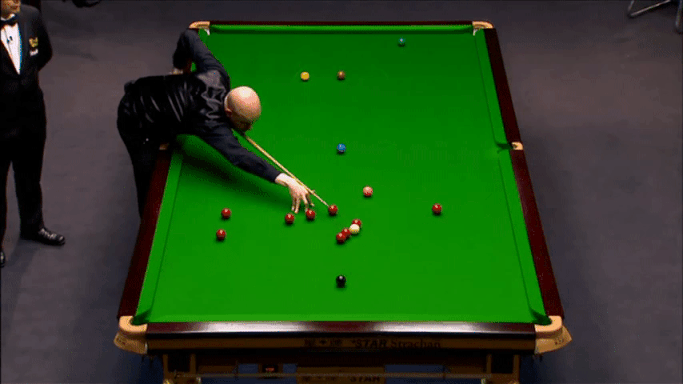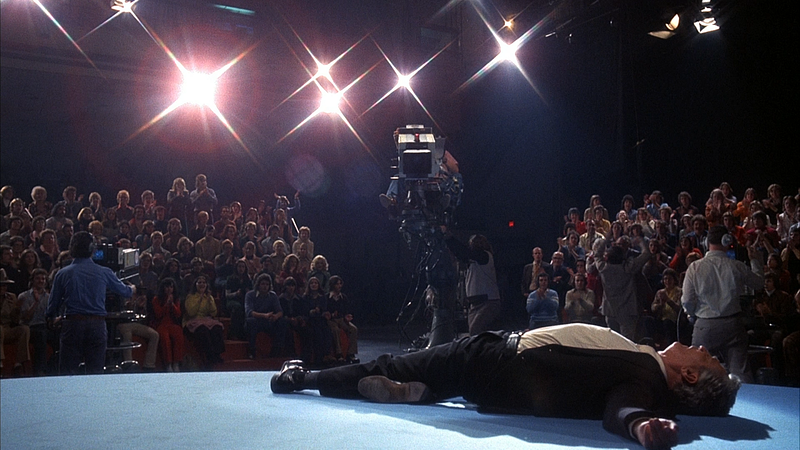SUPERHUMANITY CONVERSATIONS: BENEDICT SINGLETON AND MARTE FERREIRA DE SÁ RESPOND TO KELLER EASTERLING, “NO YOU’RE NOT”
Winning
Benedict Singleton and Marta Ferreira de Sá
Film still from Sidney Lumet’s Network (1976).
We read “No You’re Not” less as an essay than as a pitch. A pitch proposes a course of action to an audience, specifically one which requires their involvement if it is to take place. This immediately makes the pitch very different than the kind of argument that Easterling describes. When an argument is addressed to an audience, it demands they acknowledge it as correct. A pitch, in contrast, offers something to them, in the knowledge they might say no. One does not need to pitch if one is in a position to can issue a command: if you are in a position to say “let it be so,” and then have it be so, you are on the receiving end of pitches—you are the audience, not stood in front of it. Pitches, then, trade off persuasion, not insistence, and aspire to be seductive, which it would be naive to automatically equate with deceit.
If pitches are therefore a means of appealing to people in a position of power over you, the pitch shouldn’t be mistaken for the plea. Both pitch and plea ask for something from the audience, but the plea does not offer anything in return. This gives them a certain symmetry with the kinds of argument Easterling talks about: both the plea and the argument demand the audience give something up. Because they table a sacrifice, the plea and the argument have a certain religious tenor. The pitch, on the other hand, is profoundly secular: it solicits an investment (as measured in time, money, or whatever one’s favored unit) by describing the form that investment can take, and the rationale for doing so. The fact that, in moments of extreme desperation, people tend to mix an argument with a plea—to ask at once to be acknowledged as correct, and simultaneously also for a favor—is indicative of how close the two are, and how distant from the pitch.
Let’s consider, then, what is a pitch is made of, and how it works. In their simplest form pitches can be verbal and short, but considering them as a design object will put emphasis on their remarkable and intriguing elasticity.
The pitch, as a designdesigned object object, is capable of bringing many different kinds of material together, especially as the stakes—the resources being pitched for—increase. Clearly, an architect’s pitch to a client might be composed of diverse materials: sections, elevations and plans, models and renders, cost lists costs and timelines. But while the architect might consider all of these in relation to the final object, typically a building, this disguises how the pitch must be is a distinct object of design in and of itself, with a coherent structure, in which these different media must be staged to work together with each other.

Even at the lower levels of politics and commerce, a contemporary pitch might include text, calculations, images still and moving, diagrams, historical account and future projection, models or prototypes that prove principles and demonstrate plausibility and moments of deliberate surprise or predictable confirmation. The design of a pitch is what strings these together into a sequence enacted by a (usually) physical performance welding them into a narrative, the aim of which is to be compelling. The communication of what is plausible as well as desired—the description of principles of activity and operation, rather than the simple visions of the plea—are critical to achieving this.
Facing the pitcher is the audience, be they one or many, who bring to the proceedings , be they one or many, a complexity all of their own. Everything about a pitch is calibrated towards acquiring their consent. Achieving this requires throwing a myriad of switches, pulling levers, unstopping corks and spinning plates.
Even the most minimal verbal pitch needs to negotiate and play the subtle movements and unconscious presence of different programs, expectations and habits of thought at the table. Stirring enthusiasm while pre-empting objections; delineating options while maintaining focus, almost like making a promise without promise to keep it; remaining open while providing unflinching direction: the materials of the pitch must map onto the agendas of the audience in such a way as to lead them from where they are, now to a point where there will be a “yes” or “no” (and of course to tilt the proceedings to the former). The question of the pitch is a moment where a course of action is considered to have really only just begun, or undeniably have ended.
Who can avoid being fascinated by these situations, in which such potentially huge forces are channeled into such a narrow window of space and time? If there is an aesthetic to this, which could be almost referred to as the beauty of success, it runs deeper than simply achieving the verdict of “yes.” In light of which, one cannot but enquire what makes such an event successful.
A pitch can win out against other pitches, and still be poor. “The best of all presented options” is a relevant category, but always relative; not an indicator of excellence in itself. The measure of success is to be found in the judgment of the pitcher. The most elegant pitches are those that use the least time and material possible to effectively throw the broadest field of switches. This is to say, they operate as levers. The lever is a simple instrument, placed exactly so, in order to align larger forces with one’s own objectives. Leverage is the de facto art of the pitcher, just as it is that of the blackmailer, racketeer and other, more acceptable, species of financier.
Understanding this is critical to grasping the operations of strategy, and there is huge potential, we think, in the movement of the design disciplines and the fields that neighbor them in this direction. As with the pitch, other kinds of objects will emerge as “design objects,” continuously changing and challenging the landscape surrounding our practice. And just like the pitch, other kinds of objects worthy of such attention will emerge and continuously change and challenge the landscape surrounding our practice.
×
Benedict Singleton and Marta Ferreira de Sá are the founders of Rival Strategy, a London-based consultancy focused on maximizing the strategic potential of services, technologies, places and organizations.
